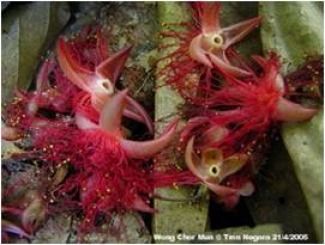Cues in mass flowering of Dipterocarpaceae
Summary
The trees of the Dipterocarpaceae family comprise a major forest type in Southeast Asia. This forest type is of great economic importance to the region because of its hard wood. Also, a great variety of wildlife depends on diptrerocarps for seeds and fruits. The trees of this family exhibit a peculiar phenology of irregular mass flowering which has been the topic of controversy for years. They don’t seem to respond to a common environmental cue as do other mass flowering species. Various signs have been studied in the past. Some studies identified unusual drought as the trigger for mass flowering of dipterocarps. Other studies have found a correlation with El Niño and the occurrence of mass flowering. And yet another study reported a drop of a minimum night time temperature as the main trigger of flowering. So there are discrepensies in the understanding of mass flowering cues. The unpredictability of flowering makes it hard for forest managers to decide when the best time of harvest should be. If the forest is harvested prior to producing seeds, regeneration will be difficult.
Photo 1: Shorea Flowers. Source: www.giantleaf.com
In this project I want to explore different environmental cues of mass flowering in different regions of Southeast Asia. I compiled and analyzed long term phenological data from previous studied using an array of univariate and multivariate statistical techniques. The results of principle component analysis, classification and regression tree, cluster analysis, non parametric multidimentional scaling will be discussed in this research. Regional weather trends and associations with El Niño will be investigated in this project in order to understand why different cues are involved. Finally, predictions of mass flowering using random forest software in R are attempted in this project.
Mariya Chechina. PhD Student
Department of Renewable Resources
University of Alberta
Department of Renewable Resources
University of Alberta


